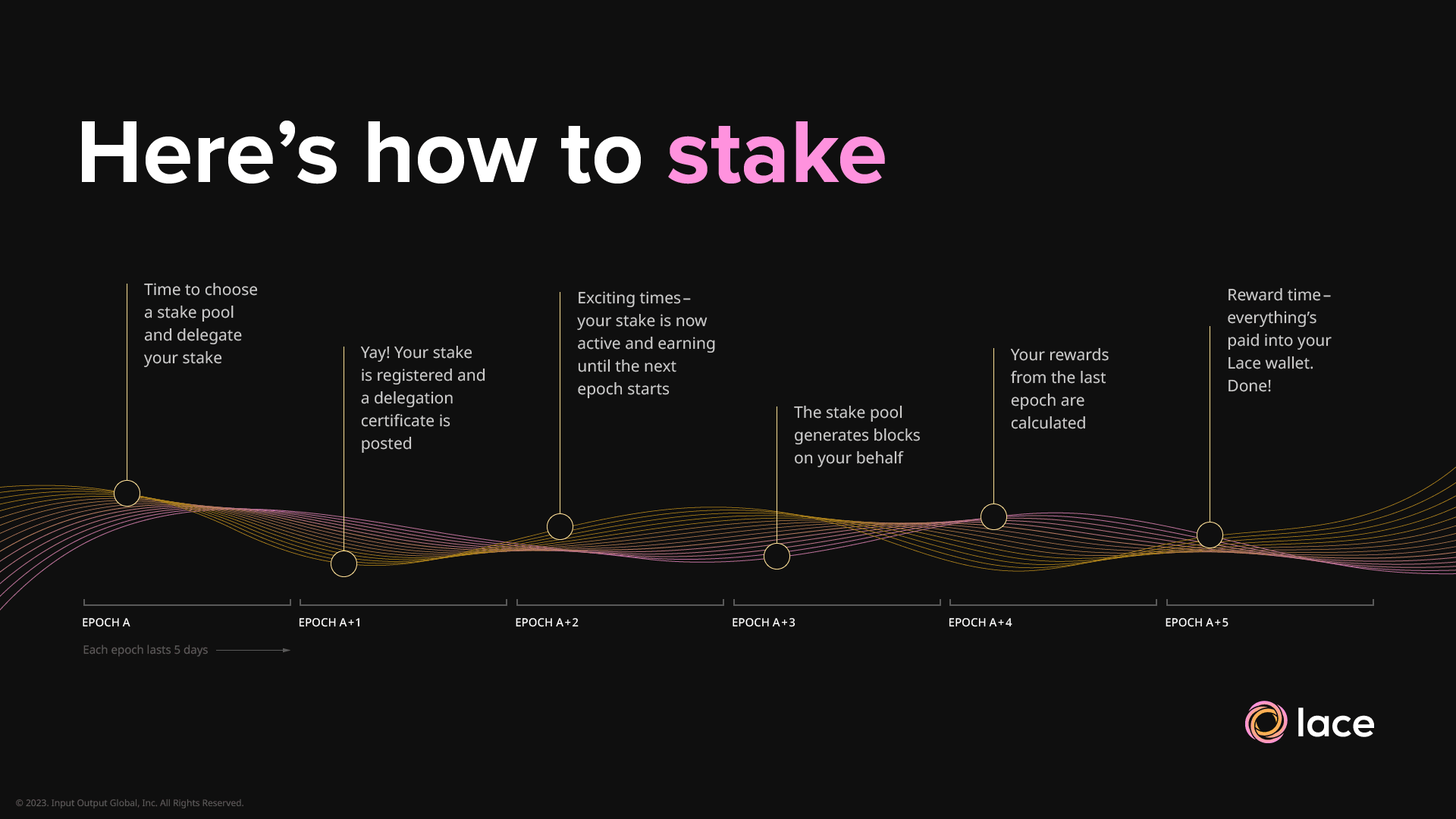The Lace platform is all about simplicity and ease of use. It's about giving you, the user, a positive experience while using Lace for your Web3 life. Lace aims to become your go-to Web3 platform for decentralized applications (DApps), digital assets, decentralized finance (DeFi), and non-fungible tokens (NFTs).
Not only is Lace super approachable and usable, Lace lets you easily stake your ada and earn rewards. By staking your ada, you help support and promote decentralization across the entire ecosystem – what's not to love? More on this in a bit.
Of course, there are other layers to Lace. An NFT Gallery, for example. With a visually appealing design, this showcases your NFT collection. It's like your very own display cabinet for all those cool NFTs you've acquired, and for any new ones that you might add to your collection.
Staking, you say?
Mention the word staking, and some might think of B movies, the undead, and amateur vampire hunters. Nothing intrinsically wrong with that thought, but in Proof of Stake (POS), staking means something altogether different, and not quite so violent.
In proof-of-stake chains, staking is the process of delegating some (or all) the balance in a user’s wallet to a designated stake pool to contribute to the security of a blockchain. Specifically to Cardano, staking is the process of delegating some (or all) of a user's ada to a stake pool of their choosing and earn delegation rewards for providing such service to the network. Essentially, ada holders delegate the right to make blocks to a stake pool.
Now, there are several concepts here that need a bit of explaining:
- Delegation: you can choose to delegate the right to produce blocks to a stake pool. This makes you an active participant in the consensus protocol for which you receive rewards. Unlike other POS blockchains, you don’t lock your stake or send it directly to a stake pool. You only delegate your block production rights, so your funds are always safe in your wallet and can actively be used.
- Stake pool: a computer running the Cardano node to validate transactions and produce blocks. Each pool holds the combined block production rights associated with the stake of multiple ada owners that have delegated to the stake pool. There is an upper limit to how much stake can be associated with a stake pool in order to prevent centralization.
- Rewards (or staking rewards): Each epoch (5 days) active members of the Cardano protocol get rewarded for their work in maintaining the chain and minting blocks. The protocol automatically and directly pays to the reward accounts of the users. These are both stake pool owners and delegators.
In short, the staking-rewards system supports Cardano's security and decentralization and ensures the longevity, security, and health of the entire ecosystem. The incentive mechanism is underpinned by scientific research combining mathematics, economic theory, and game theory.
Rewards calculation
To understand how rewards are calculated, let’s take a look at the delegation process in a bit more detail.
The delegation process actually includes five phases that span five epochs. Each epoch lasts five days:
- Delegation (epoch N)
- Snapshot (epoch N+1)
- Active stake (epoch N+2)
- Rewards calculation (epoch N+3)
Rewards distribution (epoch N+4)
First-time delegation (epoch N)
You choose the amount of ada to delegate to a pool. This action creates a delegation certificate on the blockchain.
Snapshot (epoch N+1)
The system takes a snapshot of the ada amount that your wallet held at the last block of the previous epoch (N).
Active stake (epoch N+2)
The amount measured by the snapshot becomes the active stake. The protocol uses this amount to give the pool a higher likelihood/probability of creating a block. If the pool is performing and honest in the block creation process, then you’ll both receive rewards from the protocol.
Rewards calculation (epoch N+3)
The protocol calculates the rewards based on the active stake amount and performance of the stakepool reflected on the snapshot taken two epochs prior.
Rewards distribution (epoch N+4)
The protocol distributes the rewards as calculated during the previous epoch.
After your first delegation, your active stake will continue to receive rewards at the start of each epoch. You can also redelegate to another stake pool in case your current choice is under performing.
An example:
- If you delegated from epoch 223, you will receive rewards on epoch 227
- If you delegated from epoch 224, you will receive rewards on epoch 228,
and so on.
Note: If a wallet has already been delegated, in a Nami single-address wallet for example, and then restored in Lace, the delegation continues unchanged. Generally, the four initial epochs for existing wallets that have already been delegated are in the past, and rewards continue pouring in each epoch.

Why everyone's ada matters
Lace loves ada, and ada loves Lace (get it?). It’s a match made in Web3 heaven. As of mid 2023, there are almost 3,200 stake pools in operation, and almost 23bn worth of ada is staked. And the more ada staked, the more decentralized and secure the network is. Now that’s a big incentive to staking! So, any ada that is not being staked does not earn any rewards since no service is being performed for the benefit of the blockchain.
Recap
- Staking is the process of actively delegating some (or all) ada to a chosen stake pool
- ada remains unlocked at all times
- Staking keeps Cardano secure and supports decentralization
- The delegation process includes five phases:
- Delegation (epoch N)
- Snapshot (epoch N+1)
- Active stake (epoch N+2)
- Rewards calculation (epoch N+3)
- Rewards distribution (epoch N+4)
- Each epoch lasts five days
- Rewards are distributed 20 days after first delegation
Stay up to date on all things Lace
Lace is a Web3 platform for everyone – regardless of their blockchain knowledge or background – to discover and enjoy a new world of digital experiences. More than just a wallet for the Cardano ecosystem, Lace brings together digital assets, network participation, and access to NFTs, DApps, and DeFi services in a safe, quick, and easy-to-use platform.
Visit Lace.io today to register for updates, add the Lace wallet to your browser, watch this video, and check out other unique features.

